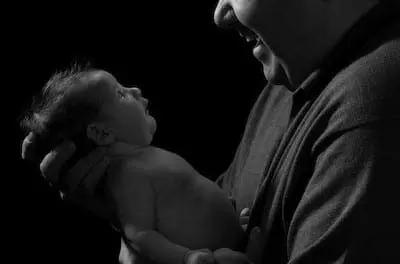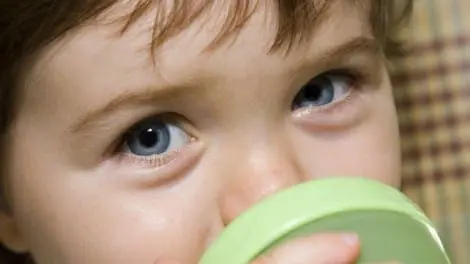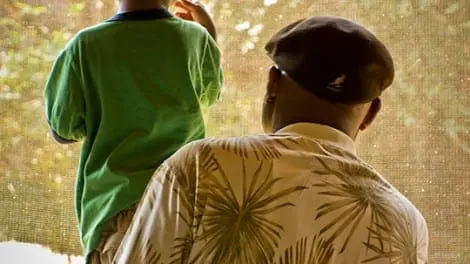DPA Magazine
It′s Never Too Early!
It’s never too early to start creating images! Use directional back lighting and a simple reflector to create black and white images with impact.
Get Closer for Better Portraits
Want to take portraits with more pizazz? Try coming in closer by using the zoom or actually stepping closer to your subject. Don’t be afraid to fill the frame, but watch your focus. Getting your subject’s eyes in focus is critical. If your lens is wide, stepping in too close sometimes can distort a person’s face, so try using the zoom. Longer lenses are generally more pleasing for a portrait. Pay attention to the background, too. Get rid of any distracting elements. Once you’re in close, the built in flashes on most cameras will be too harsh. Try turning off the flash and using some pleasing window light. Sometimes you want to see an entire face, but if you want to connect just to gorgeous blue eyes, go ahead! And for Father’s Day, you can have that fabulous portrait printed onto numerous items these days – coffee mugs, mouse pads, bookmarks. What a personal gift that Dad will treasure!
Seattle, WA ñ PikeÃs Place Market
Wide-Angles: Angle your camera a little to one side or the other to make compositions more dynamic and add a little edge. Use a camera that has a wide-angle lens (25mm-28mm), so you can get more shot in your frame than a standard 35mm lens.
Lit-House
Didn′t your mother always tell you to never shoot in bright noon-day sun? Well, I found myself on Assateague Island, Virginia, stalking its famous icon The Assateague Lighthouse. Composing the image under some welcome shade, I delighted in the way the leaves of this tree framed the lighthouse itself. With a little tweaking of my composition, I placed the lighthouse in the wide open blue negative space. Lovely, but JUST ONE PROBLEM! The leaves looked positively dark and silhouetted against all that bright blue. (Mother was right!) So, I flipped open my on-camera flash and began a dance with two adjustments: FILL FLASH and EXPOSURE COMPENSATION. On the one hand, I was turning down the flash output using the lovely +/- flash compensator, and on the other hand I was darkening the sky slightly using the exposure +/- compensator. I was very chatty and consternated as I juggled to get the balance just right. I had drawn a crowd of utterly amused tourists who thought I had blown a gasket. I was happy to amuse, and happier still to get the shot!
ANYTHING can be a Photograph!
This shot was taken in the most recent DPA Intermediate Philadelphia workshop as I illustrated that, yes, ANYTHING, can be a photograph! Keep your eyes down at all times and fasten your seat belts. Ye Olde Philadelphia Electric Manhole ©2008 Rick Wright
Panoramic Image with Panasonic DMC-L1 and DMC LX-2
Photoshop CS3 has a very robust “Photomerge” feature which allows you to take multiple exposures over a wide angle of view and “stitch” them together to make dynamic panoramic images. There are some steps to follow to get the most out of this ability, however... You need to be shooting in RAW format; if you have not yet started doing so, you should explore the capabilities of RAW and the processing that is involved after the image capture. We are going to assume you are familiar with RAW file processing, so let’s get started. For optimum quality, the camera should be mounted on a tripod with a good head which will allow you to pan in smooth increments across the field of view you wish to capture. However, it IS possible to get great results at times in hand-held mode. Both of the images shown here were captured without a tripod. In either case, you need to overlap each image about 1/3 of the field of view. This allows the software to detect repeating patterns and line up the images precisely. In the one of the cityscape, I had the camera oriented vertically, and I overlapped in small increments. This resulted in a total of 12 exposures to get this field of view. The camera should be on manual focus, and manual exposure. Use your histogram to fine tune your exposure, and shoot each exposure at the same setting. Also, it will be more convenient if you have your white balance set on one setting, say, daylight, rather than on auto, as that would result in slight variations as the sensor picks up different areas of light. Of course, all can be set to one setting in the RAW processor, but it’s easier to visualize if everything is consistent. Highlight the exposures you have made that will make up the finished image, and open them in Adobe Camera Raw, whether in Lightroom or Bridge/Photoshop. I prefer to select all of the images, and make my adjustments (Highlight, shadow, noise, saturation, etc) on all at the same time. When you are finished, click “Done.” In Photoshop, go to File>Automate>Photomerge and you will get a dialog box where you can select the files to use for the finished image. It’s probably best to select the “Auto” option at the left, at least until you get used to working with the action. Once you select everything and click “OK,” Photoshop does its work. When it has made your composite, you will probably have to crop some edges out, and possibly clone along an edge or two as well. You may have a a seam or two that needs repair, especially in a continuous tone area like a sky, but I think you will be amazed at how well Photoshop does its magic as long as your basic exposures were on the money and consistent. Flatten the layers, and you can continue to do all your Photoshop tweaking as you would on any other image. The photo of Red Rock Canyon near Las Vegas was done on my Panasonic DMC LX2, an advanced “point-and-shoot” camera that I bought specifically because of its ability to shoot in the RAW format, enabling me to come away with images that look this good from a camera that can easily be carried when i don’t want to be encumbered by my whole professional kit. Give Photomerge a try, and take your photography to a whole new plateau!
Light, Color, and the Rule of Thirds
Here is a photo taken at The Houston Zoo during one of our Panasonic Digital Photo Academy Advanced Classes. It illustrates a number of topics, among them what the famous photographer Jay Maisel likes to refer to as “light, gesture, and color.” It also shows that a photograph doesn’t have to involve a face of a person/persons to tell a story. And our good buddy, “the rule of thirds,” is invoked by the position of the bodies and the little boy’s head. The screen they are looking through adds some texture, and gives separation between the subject plane and the background. The warmth of the afternoon sun is enhanced by the similar tones in grandpa’s hat and shirt, and since we were shooting in RAW, we were able to adjust out white balance after-the-fact to enhance this wonderful warm feeling. And grandpa’s slight lean to the right helps add “movement” in the composition, offsetting the little boy’s vertical line. Being alert to images right in front of your nose will help prove the old adage that “Luck is when preparation meets opportunity...”
Give Yourself an Assignment: Color
When I arrive in a new place without a clear idea of what I want to photograph, I try and give myself an assignment. In this case it was how to see color. These three photos were taken in the Adams Morgan neighborhood of Washington DC. The morning began with fog and drizzle and gave way to a sparkling afternoon. The row of houses was first on my list, with a gray sky and yet these stand out colors. I wondered what might happen if a house was sold to someone who wanted a gray house. But these houses started me thinking about the used of color and how it appears randomly. Here is a wall I passed and love the bright red brick and the design of the faded poster with the red wall showing through in places. This a pocket park with the colors on the wall and in the old water of the bird bath playing off one another. Finally, this shot is later in the day at a protest rally where the the colors of the city once again fell into place for me, as I looked for primary color combinations.
UpShots: Low Altitude Aerial Photography
I’ve often thought of how wonderful it would be to have the ability to hover over things; to quietly observe their shapes and patterns, seeing them on new and different levels. Hummingbirds always fascinated me for their ability to actually do this and I was always a little envious of their skills and of the vantage points they could so easily obtain. The Bridge of Flowers, Shelburne Falls, MA Developing a system to photograph from a significant height became a bit of an obsession for me. I knew that shooting from rooftops was incredibly satisfying, but I wanted to take the building with me. I got my chance for figuratively doing this while exploring the idea of lifting my camera with a helium balloon and having a video link to where I was standing on the ground. The Captain William Smith Home, Battle Road, Lincoln, MA-2 This in itself is a cool idea, but as I was to find out, a LOT of gear was called for (not the least of which was an 18-foot-long trailer to haul the rig around), making the venture more work than play. Adding to the downside was the fact that it moved a lot. In my continuing research, I found the “Upshots” tripod a wonderful solution for getting me my dreamed of high vantage point. This tripod consists of seven 7 foot-long, high quality, nested aluminum tubes, connected by wires and pulleys. At the top is a pan/tilt servo-motor head which allows us to control the direction the camera points and it’s tilt up or down with a simple joystick. Connecting the video out from the camera to a portable, battery powered, 9-inch color monitor, displays each exposure as it is made and provides a reference for corrections and/or variations. Our ‘preview’ is actually a captured image and we keep shooting until we get what we need. And since this is a tripod, we get the added stability to shoot in low light, something that helicopters or small planes would never allow. Christian Science Center, Boston, MA It’s not the same as flying like a hummingbird, but it’s as close as you can get without sprouting wings. Baseball Diamond from behind backstop By the way, helicopters are still my main rush and I’d never pass up a chance to shoot from one, However, in all honesty, they are noisy, expensive, dangerous, have limited duration at any one location, are shakey, subject to height and/or flight restrictions, definitely non-green, disruptive and… and did I mention expensive? Great Meadows National Wildlife Pond, Concord, MA
RAW vs JPEG
Just a quick note to show you the potential of RAW processing and some Photoshop tweaking. You remember the over exposed duck image I showed that we "tweaked" in Camera RAW? - See the BEFORE image below: I did some quick finessing during the class and you saw the improvement. Certainly not where I wanted to go with it, but improved. As a challenge, I decided to play with the shot some more on my desktop computer in Adobe Camera RAW and Photoshop. a) Processed the RAW image in Adobe Camera RAW to bring back as much wing detail as possible b) Did a Shadows Highlights correction in Photoshop to further bring in wing detail c) Clone stamped in wing detail where I couldn′t rescue it via the above means d) Darkened all the corners with the burn tool e) Extended the canvas on the right side to "Create" room for the duck to fly f) Added green pixels to the head to eliminate some of the wing shadow g) Cropped and sharpened the overall image The moral of the story is - Remember to shoot using RAW capture and if the photo looks like it has potential, keep it. The obvious throw aways should be moved to the trash, but as your Photoshop skills improve, you′ll use these skills to rescue the photo. Save these images in a "Rescue Later" file and continue to experiment!








